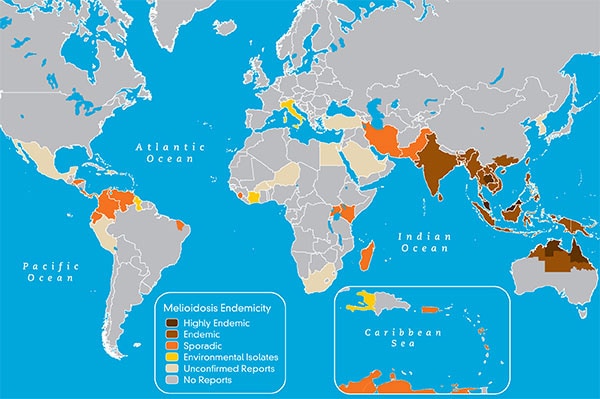CDC on Melioidosis
September 25th, 2017Melioidosis, also called Whitmore’s disease, is an infectious disease that can infect humans or animals. The disease is caused by the bacterium Burkholderia pseudomallei.
It is predominately a disease of tropical climates, especially in Southeast Asia and northern Australia where it is widespread. The bacteria causing melioidosis are found in contaminated water and soil. It is spread to humans and animals through direct contact with the contaminated source.
Transmission
 People can get Melioidosis through direct contact with contaminated soil and surface waters.
People can get Melioidosis through direct contact with contaminated soil and surface waters.
Humans and animals are believed to acquire the infection by inhalation of contaminated dust or water droplets, ingestion of contaminated water, and contact with contaminated soil, especially through skin abrasions.
It is very rare for people to get the disease from another person. While a few cases have been documented, contaminated soil and surface water remain the primary way in which people become infected.
Besides humans, many animal species are susceptible to melioidosis, including:
- Sheep
- Goats
- Swine
- Horses
- Cats
- Dogs
- Cattle
Signs and Symptoms
 There are several types of melioidosis infection, each with their own set of symptoms.
There are several types of melioidosis infection, each with their own set of symptoms.
However, it is important to note that melioidosis has a wide range of signs and symptoms that can be mistaken for other diseases such as tuberculosis or more common forms of pneumonia.
Localized Infection:
- Localized pain or swelling
- Fever
- Ulceration
- Abscess
Pulmonary Infection:
- Cough
- Chest pain
- High fever
- Headache
- Anorexia
Bloodstream Infection:
- Fever
- Headache
- Respiratory distress
- Abdominal discomfort
- Joint pain
- Disorientation
Disseminated Infection:
- Fever
- Weight loss
- Stomach or chest pain
- Muscle or joint pain
- Headache
- Seizures
The time between an exposure to the bacteria that causes the disease and the emergence of symptoms is not clearly defined, but may range from one day to many years; generally symptoms appear two to four weeks after exposure.
Although healthy people may get melioidosis, the major risk factors are:
- Diabetes
- Liver disease
- Renal disease
- Thalassemia
- Cancer or another immune-suppressing condition not related to HIV
- Chronic Lung disease (such as cystic fibrosis, chronic obstructive pulmonary disease (COPD), and bronchiectasis)
Risk of Exposure

While melioidosis infection has taken place all over the world, Southeast Asia and northern Australia are the areas in which it is primarily found.
In the United States, confirmed cases reported in previous years have ranged from zero to five and have occurred among travelers and immigrants coming from places where the disease is widespread.
Moreover, it has been found among troops of all nationalities that have served in areas with widespread disease.
The greatest numbers of melioidosis cases are reported in:
- Thailand
- Malaysia
- Singapore
- Northern Australia
Though rarely reported, cases are thought to frequently occur in:
- Papua New Guinea
- Most of the Indian subcontinent
- Southern China
- Hong Kong
- Taiwan
- Vietnam
- Indonesia
- Cambodia
- Laos
- Myanmar (Burma)
Outside of Southeast Asia and Australia, cases have been reported in:
- The South Pacific (New Caledonia)
- Sri Lanka
- Mexico
- El Salvador
- Panama
- Ecuador
- Peru
- Guyana
- Puerto Rico
- Martinique
- Guadeloupe
- Brazil
- Parts of Africa and the Middle East
Treatment

When a melioidosis infection is diagnosed, the disease can be treated with the use of appropriate medication.
The type of infection(https://www.cdc.gov/melioidosis/signs-symptoms.html) and the course of treatment will impact long-term outcome. Treatment generally starts with intravenous (within a vein) antimicrobial therapy for 10-14 days, followed by 3-6 months of oral antimicrobial therapy.
Antimicrobial agents that have been effective against melioidosis include:
Intravenous therapy consists of:
- Ceftazidime administered every 6-8 hours
- OR
- Meropenem administered every 8 hours
Oral antimicrobial therapy consists of:
- Trimethoprim-sulfamethoxazole taken every 12 hours
- OR
- Doxycycline taken every 12 hours
Patients with penicillin allergies should notify their doctor, who can prescribe an alternative treatment course.
Prevention
 (https://www.cdc.gov/melioidosis/transmission/index.html)In areas where the disease is widespread (see map below), contact with contaminated soil or water can put people at risk for melioidosis.
(https://www.cdc.gov/melioidosis/transmission/index.html)In areas where the disease is widespread (see map below), contact with contaminated soil or water can put people at risk for melioidosis.
However, in these areas, there are things that certain groups of people can do to help minimize the risk of exposure:
- Persons with open skin wounds and those with diabetes or chronic renal disease are at increased risk for melioidosis and should avoid contact with soil and standing water.
- Those who perform agricultural work should wear boots, which can prevent infection through the feet and lower legs.
- Health care workers can use standard contact precautions (mask, gloves, and gown) to help prevent infection.
Endemicity of Meliodosis Infection

Healthcare Workers
Diagnosis
Melioidosis is diagnosed by isolating Burkholderia pseudomallei from blood, urine, sputum, skin lesions, or abscesses; or by detecting an antibody response to the bacteria.
Infection Classifications
Melioidosis can be categorized as an acute or localized infection, acute pulmonary infection, acute bloodstream infection, or disseminated infection. Sub-clinical infections are also possible. The incubation period (time between exposure and appearance of clinical symptoms) is not clearly defined, but may range from one day to many years; generally symptoms appear two to four weeks after exposure. Although healthy people may get melioidosis, the major risk factors are diabetes, liver disease, renal disease, thalassemia, cancer or another immune-suppressing condition not related to HIV.
Localized Infection
This form generally presents as an ulcer, nodule, or skin abscess and may result from inoculation through a break in the skin and may produce fever and general muscle aches. The infection may remain localized, or may progress rapidly through the bloodstream.
Pulmonary Infection
This is the most common form of presentation of the disease and can produce a clinical picture of mild bronchitis to severe pneumonia. The onset of pulmonary melioidosis typicall is marked by a high fever, headache, anorexia, and general muscle soreness. Chest pain is common, but a nonproductive or productive cough with normal sputum is the hallmark of this form of melioidosis. Cavitary lesions may be seen on chest X-ray, similar to those seen in pulmonary tuberculosis.
Bloodstream Infection
Patients with underlying risk factors such as diabetes and renal insufficiency are more likely to develop this form of the disease, which usually results in septic shock. The symptoms of bloodstream infection may include fever, headache, respiratory distress, abdominal discomfort, joint pain, muscle tenderness, and disorientation. This is typically an infection with rapid onset, and abscesses may be found throughout the body, most notably in the liver, spleen, or prostate.
Disseminated Infection
Disseminated melioidosis presents with abscess formation in various organs of the body, and may or may not be associated with sepsis. Organs involved typically include the liver, lung, spleen, and prostate; involvement of joints, bones, viscera, lymph nodes, skin, or brain may also occur. Disseminated infection may be seen in acute or chronic melioidosis. Signs and symptoms, in addition to fever, may include weight loss, stomach or chest pain, muscle or joint pain, and headache or seizure.
Bioterrorism
Melioidosis is a disease caused by germs that occur naturally in certain parts of the world(https://www.cdc.gov/melioidosis/risk.html), such as Southeast Asia and northern Australia. The only place these germs, called Burkholderia pseudomallei, occur naturally in the United States is Puerto Rico. Usually, people in the United States (outside of Puerto Rico) who get the disease have traveled and come into contact with the germs in one of these places where they occur naturally. One reason public health authorities study the disease is because it is possible that the germs that cause melioidosis might be used in a biological attack. A biological attack is the intentional release of germs that can sicken or kill people, livestock, or crops.

